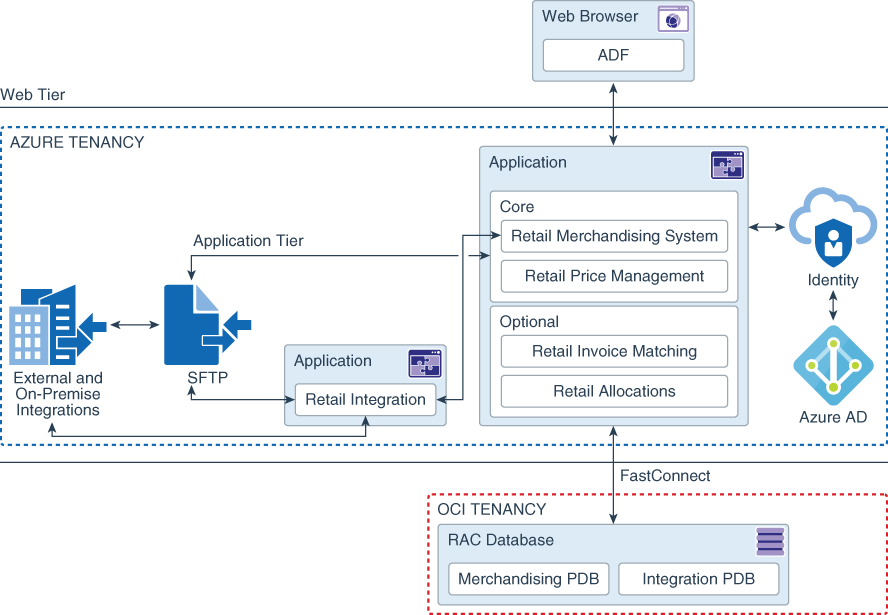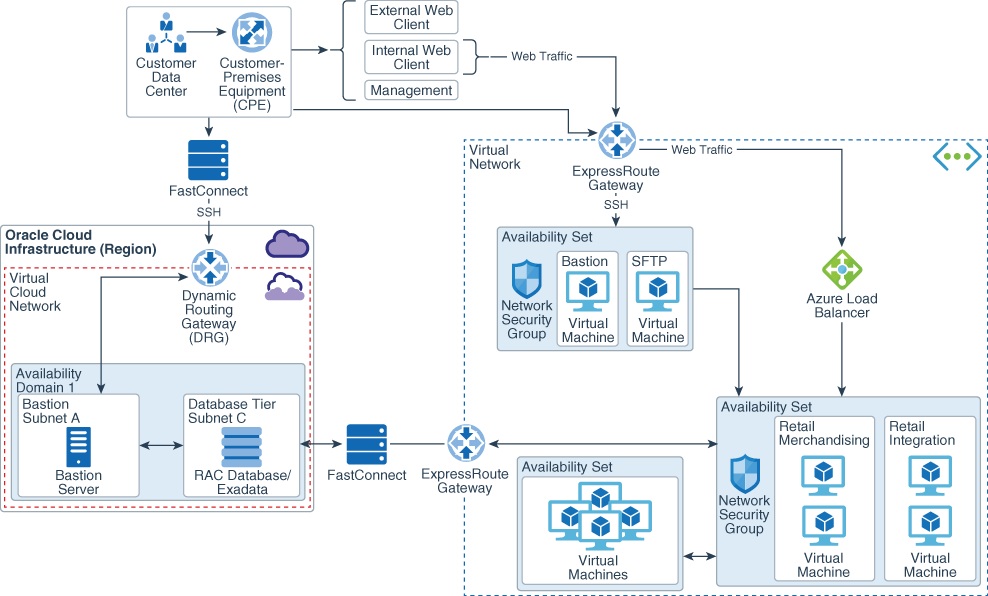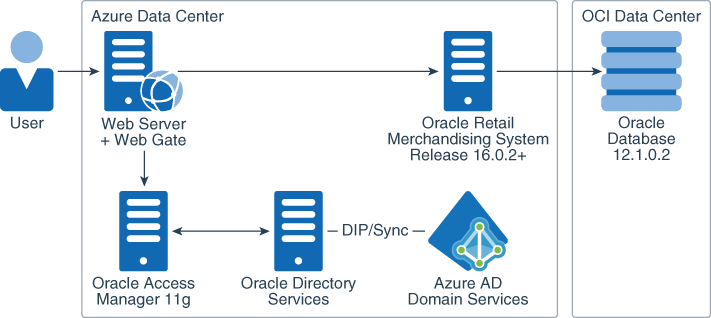About Setting Up SSO Between Azure AD and Oracle Access Manager for Oracle Retail Merchandising Suite
This solution provides a reference architecture for implementing Oracle Retail Merchandising Suite on Microsoft Azure and associate it with a database running on Oracle Cloud Infrastructure. Using both clouds gives customers added flexibility as they move to the cloud.
This cross-cloud solution for Retail Merchandising Suite places the database tier on Oracle Cloud Infrastructure and the middleware tier, F tier (firewall, proxies, and load balancer), and DS tier on Microsoft Azure. Additionally, this architecture uses Azure Active Directory (Azure AD) as the federated identity provider (IDP) to authenticate a user to the Retail Merchandising Suite, while Oracle Access Manager is the service provider (SP).
Herein, you will find high-level instructions for installing the Retail Merchandising Suite in the cross-cloud model and configuring SAML 2.0 federated single sign-on (SSO) with Azure AD, through Oracle Access Manager. You should possess an understanding of Oracle Retail Merchandising cross-cloud architecture to understand this authorization integration.
Before You Begin
See Learn about interconnecting Oracle Cloud with Microsoft Azure.
Understand SSO with Oracle Access Manager and Azure AD
In this architecture, the backend LDAP store is Oracle Internet Directory; however, the system of record for users is Azure AD. Oracle Directory Integration Platform serves as a bridge between Oracle Internet Directory and Azure AD by synchronizing user information from Azure AD to Oracle Internet Directory. This synchronization allows Oracle Internet Directory to continue to act as the backing store for Oracle Access Manager, which in turn allows the existing integration between Oracle Access Manager and Retail Merchandising to function as in all other deployment models. In this cross-cloud model, Azure AD performs authentication and Oracle Access Manager performs authorization.
Architecture
To implement this cross-cloud solution, you should first understand the three architectures that implement it.
- Physical architecture
- Logical architecture
- Authentication and authorization architecture
Understand the Logical Architecture
The Retail Merchandising Suite reference architecture consists of three logical tiers and the components that comprise these tiers.

Description of the illustration merch-logical-arch.png
- Web tier: Oracle ADF-based UIs that are accessible from a web browser
- Application tier:
- Retail Merchandising Suite applications.
- Retail Integration Suite (including Retail Integration Bus, Retail Service Bus, and Retail Bulk Data Integration).
- Identity Management through Oracle’s Identity Management stack (Oracle Access Manager, Oracle Identity Manager, and Oracle Internet Directory).
- Connections for transferring files with SFTP and other integrations .
- Data tier: Merchandising and Integration Pluggable databases on an Oracle RAC Database.
Understand the Physical Architecture
At a high level, the cross-cloud model lets retailers deploy their data tier in Oracle Cloud Infrastructure and their application tier in Microsoft Azure.

Description of the illustration merch-physical-arch.png
The reference architecture clusters database and compute nodes to produce a highly scalable, highly available architecture. FastConnect between Oracle Cloud Infrastructure and Azure ensures reliable performance that meets all service level agreements (SLA).
- Database tier on Oracle Cloud Infrastructure (OCI)
- Middleware tier (with a high-performance network file system) on Azure
- F tier (firewall, proxies, and load balancer) on Azure
- DS tier (SFTP) on Azure
Understand the Authentication and Authorization Architecture
The authentication and authorization architecture is based on an integration between Oracle Access Manager and Retail Merchandising Suite.

Description of the illustration merch-authn-authz-arch.png
Oracle Access Manager requires the backend LDAP store to be Oracle Unified Directory or Oracle Internet Directory. In this architecture, the system of record for users is Azure AD. Oracle Directory Integration Platform, used as a bidirectional synchronization service, synchronizes that account to Oracle Internet Directory.
Oracle has verified and supports this cross-cloud deployment architecture for Retail Merchandising Suite 16.0.2 and later, including federated SSO through the processes described in this document.
About Required Services and Roles
This solution requires the combination of specific services and roles within those services.
- Oracle Cloud Infrastructure
- Oracle Access Manager
- A fully functional Oracle Retail Merchandising Suite instance deployed to Azure
- Microsoft Azure AD
Roles required are:
| Service Name: Role | Required to... |
|---|---|
| Oracle Cloud Infrastructure: Administrator | Create and manage identity resources |
| Oracle Access Manager: Administrator | Configure and maintain user settings on-premises |
| Retail Merchandising: Administrative roles, includiing database administrator and LDAP administrator | Configure Retail Merchandising and change security settings |
| Azure AD: contributor or greater privileged account | To obtain an Azure subscription |
| Azure AD: application or global administrator | Handle configuration and set up on the Azure side |
Describe the consideration.